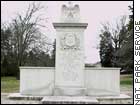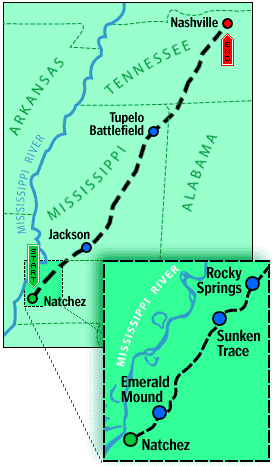
NASHVILLE, Tenn. (CNN/Money) -
Most Americans have heard of the Blue Ridge Parkway, the magnificent scenic byway administered by the National Park Service. But not as many people seem to realize that the Park Service also has another road under its auspices: the Natchez Trace Parkway.
The NTP runs 443 miles from Natchez, Mississippi, to Nashville, Tennessee. Unlike the Blue Ridge Parkway, whose route was determined by planners and engineers, the Natchez Trace Parkway follows a previously existing route: the old Natchez Trace, a pre-Columbian walking trail that remained an important and heavily traveled pathway until the 1820s, when steamboats made it obsolete.
The NTP was established in 1938. Much like the BRP, it is a two-lane blacktop with no stop signs or traffic lights, a 45-mph speed limit, and numbered stone markers counting off the passing miles. The countryside is lovely, especially in the NTP's most southerly stretches, where roadside trees are often dripping with kudzu or Spanish moss. And there's no shortage of interesting stops along the way -- some of them along the NTP itself, others in nearby towns. Here are some of my favorites, running from Natchez to Nashville:
Emerald Mound
Native American burial mounds are located throughout much of the United States, and Mississippi (which was named after an Indian tribe) is particularly fertile territory for them. The Emerald Mound, a massive, grass-covered plateau located at mile marker 10.3, near the NTP's southern terminus, is the second-largest Indian mound in the country. It measures 770 by 435 feet at its base and rises to 35 feet.
It is thought to have been used between the years 1250 and 1600. Walking trails allow visitors to climb up the mound, and interpretive displays explain how the mounds were built and the ceremonies, in which corpses and artifacts were buried, that were held there.
Sunken Trace
Although the NTP parallels the route of the old Trace pathway, the Trace itself is gone -- almost. Small sections of it have been preserved, the most evocative of which is called the Sunken Trace, at mile marker 41.5. Although the Sunken Trace is just a short walk from the roadway and only about 200 yards long, it feels like another world. As its name suggests, it's deeply eroded into the ground, like a giant ditch or channel. Its earthen walls and the canopy of trees overhead give it a feeling of isolation, and it's surprisingly easy to lose yourself in experience as you walk along its length, imagining what it must have been like to traverse the Trace's entire length in the days before European settlers arrived.
Rocky Springs

Located on the NTP at mile marker 55, Rocky Springs is a ghost town, and a fascinating place to explore. Founded in 1837, the town was a thriving community by 1860, but then a series of disasters began: Union troops looted the town during the Civil War; a yellow fever epidemic decimated the town's population; the boll weevil wreaked havoc with the cotton crop; and then the town's titular springs went dry. By 1920, Rocky Springs was dead. What's left of it -- a few artifacts, some building foundations, and a church with absolutely the most gorgeous cemetery you'll ever see -- has been preserved as a historic exhibit, and is a must-see for anyone traveling the NTP.
Jackson, Mississippi
The NTP passes right through the city of Jackson, which is Mississippi's capital and has a number of interesting attractions. Chief among these is the Old Capitol Building at Capitol and State Streets. A magnificent Greek Revival structure, it was built in 1838 and used until 1903. It now functions as a museum devoted to itself and to the history of Mississippi. Also worth checking out is the Mississippi Agriculture and Forestry Museum at 1150 Lakeland Drive, which documents the state's agricultural heritage.
Tupelo National Battlefield
| |
 Related sites
Related sites
| |
| | |
| | |
|
On July 13th and 14th of 1864, Confederate General Nathan Bedford Forrest tried to cut off the railroad that was serving as the primary supply line for Union General William Tecumseh Sherman, who was advancing on his famous march toward Atlanta. Union forces, led by A.J. Smith, clashed with Forrest's contingent but ultimately fell back. The Battle of Tupelo is commemorated here, on the field where it occurred, with a memorial to those killed and some short walking trails.
Elvis Presley Birthplace
306 Elvis Presley Dr., Tupelo, Mississippi
The two cities usually associated with the King of Rock and Roll are Memphis, where he lived, and Las Vegas, where he became a pudgy kitsch icon. But Elvis was born in Tupelo, Mississippi, and his boyhood home has been preserved as a shrine. The modest two-room house, reputedly built by Elvis's father for less than $200, now features a variety of Elvis-related exhibits, including displays of clothing, mementos, and more.

|

